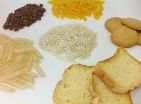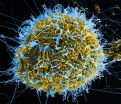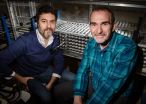(Press-News.org) Rice is one of the few cereal grains consumed by people with celiac disease, as it does not contain gluten. However, it can have high concentrations of a toxic substance – arsenic – as revealed by the analyses of flour, cakes, bread, pasta and other foods made with rice, conducted by researchers from the Miguel Hernández University of Elche, Spain. The European Union is working to establish the maximum quantities of arsenic in these products.
Celiac disease affects almost 1% of the population of the western world, a group which cannot tolerate gluten and is thus obliged to consume products without it, such as rice. But this grain, depending on its origin, can also contain worrying levels of arsenic, a toxic and carcinogenic substance.
For the majority of consumers this does not pose any problem because they do not eat much rice every day, but this is not the case for celiac disease sufferers. Researchers from the Miguel Hernández University of Elche (UMH) have analysed the presence of arsenic in flour, bread, sweets, pastas, beers and milk made with rice and intended for this particular group of the population.
The results of the analyses, presented in the journal Food Additives & Contaminants, warn that some of these products contain "important contents" of total arsenic (As-t, up to 120 µg/kg) and inorganic arsenic (As-i, up to 85.8 µg/kg). Total arsenic is the sum of the organic arsenic, which is combined with carbon, and inorganic arsenic, which reacts with other elements such as oxygen, chlorine and sulphur, and is more harmful.
With these figures the As-t and As-i contents only of rice used as a main ingredient – leaving aside the other components of the food products – were estimated and were found to be as high as 235 and 198 µg/kg, respectively.
Moreover, the daily intake of inorganic arsenic by celiac disease sufferers – a consequence of their consumption of rice products – was calculated as between 0.45 and 0.46 µg/kg (micrograms per kilogram of body weight) for women and men weighing 58 and 75 kg respectively. And, in the case of children (up to the age of five), these figures are even higher, ranging between 0.61 and 0.78 µg/kg, according to another study published in the Journal of Food Science.
A panel of experts from the European Food Safety Authority (EFSA) of the EU established in 2009 that there is evidence to suggest that an intake range of 0.3 - 8.0 µg/kg of body weight per day entails a risk of developing lung, skin or bladder cancer. The estimated intakes in the two studies therefore vary within this range.
As Ángel Carbonell, co-author of the studies, explains to SINC: "These figures show that we cannot exclude a risk to the health of people who consume these kinds of products," although he recognises an important point: "The European Union has not yet established legal limits for the maximum content of arsenic in rice and rice-based foods, though it is currently working on this."
Lack of legislation
The researchers' recommendation is clear: "What is needed is for health agencies to legislate to limit the levels of arsenic that cannot be exceeded in rice-based foods intended for consumers who suffer from celiac disease." Until now, celiac disease was diagnosed predominantly in children, but in recent years the profile has changed and one in every five people with the disease is over 65 years old.
Currently, every EU country is taking samples of these products, analysing them and conveying the results to the EFSA to draw up a database broad enough to be able to make decisions. The Spanish Agency for Consumer Affairs, Food Safety and Nutrition (AECOSAN) has recently sent the Spanish report, put together in collaboration with the researchers responsible for this study.
Another important recommendation they make is to include quality information on labels: "The inorganic arsenic content in every food product should be indicated, and the variety of rice used and its provenance should be identified clearly, because some are more recommended than others," affirms Sandra Munera, one of the authors.
Arsenic is naturally present in the Earth's crust, but in some regions its abundance is greater than in others, and its concentration also increases with the use of pesticides. The substance then spreads through water to rice, one of the few plants that is cultivated when flooded.
One of the 'cleanest' types of rice is from the Doñana National Park, as the use of pesticides has not been permitted here and arsenic is not naturally present in large quantities. On the other hand, in countries like India and Bangladesh, where waters are contaminated with inorganic arsenic and rice constitutes a staple food for the population, the result is currently one of the largest mass poisonings in history.
INFORMATION:
References:
Munera-Picazo S., Burló F., Carbonell-Barrachina A.A. "Arsenic speciation in rice-based food for adults with celiac disease". Food Additives & Contaminants A 31(8): 1358-1366, 2014.
Munera-Picazo S., Ramírez-Gandolfo A., Burló F., Carbonell-Barrachina A.A. "Inorganic and total arsenic contents in rice-based foods for children with celiac disease". Journal of Food Science 79(1): T122-128, 2014.
Pre-eclampsia, the potentially deadly condition that affects pregnant women, may be caused by problems meeting the oxygen demands of the growing fetus, according to an editorial in the November issue of Anaesthesia, the journal of the Association of Anaesthetists of Great Britain and Ireland (AAGBI).
The finding has promoted the co-author of the editorial, Associate Professor Alicia Dennis, Consultant Anaesthetist & Director of Anaesthesia Research at the Royal Women's Hospital in Melbourne, Australia, to call for the name of the condition to be changed to make women ...
This news release is available in French. Although progress has been made in recent years, the matter of youth suicide in Quebec still needs to be more effectively addressed. In fact, a new study in the Canadian Journal of Psychiatry shows that more lives could be saved through early detection and increased public awareness and information sharing among professionals.
For this research, a team of scientists from the Douglas Mental Health University Institute and McGill University studied 67 suicide completers ages 25 and under and matched them with 56 living control ...
A study recently published in the Journal of the American Academy of Dermatology shows that for Ebola, measles, syphilis and many other conditions with skin manifestations the mortality rates are hundreds of times higher in developing countries than they are in developed countries. The case of Ebola, the paper writes, "Highlights the importance of monitoring disease burden in the developing world even when the burden is low."
"Our goal is to provide information about trends and patterns to bring to light what's going on around the world so that funds can be allocated ...
CHAMPAIGN, Ill. — River beds, where flowing water meets silt, sand and gravel, are critical ecological zones. Yet how water flows in a river with a gravel bed is very different from the traditional model of a sandy river bed, according to a new study that compares their fluid dynamics.
The findings establish new parameters for river modeling that better represent reality, with implications for field researchers and water resource managers.
"The shallow zones where water in rivers interacts with the subsurface are critical environmentally, and how we have modeled ...
A new study brings good news to all the brothers out there: Having a sibling is just as good for you as it is for your sister.
That's surprising to family scholars because boys typically report that they benefit less than girls from peer relationships.
"In our study, most relationships were not as important for boys as they were for girls," said study co-author Laura Padilla-Walker. "But the sibling relationship was different – they seemed to report relying on sibling affection just as much as girls do. It's an area where parents and therapists could really help ...
PULLMAN, Wash. – Washington State University researchers have developed a new catalyst that could lead to making biofuels cheaply and more efficiently.
Led by Voiland Distinguished Professor Yong Wang, the researchers mixed inexpensive iron with a tiny amount of rare palladium to make the catalyst. Their work is featured on the cover of the October issue of the journal ACS Catalysis.
Removing oxygen for better fuel
Researchers, government leaders and industry leaders are interested in renewable biofuels as a way to reduce national dependence on fossil fuels and ...
ANN ARBOR—Adults over 50 who feel comfortable about aging are more proactive in getting preventive health care services, a new University of Michigan study found.
Sometimes, the older population does not visit their doctor because they believe that physical and mental declines typify old age, says Eric Kim, a U-M doctoral student in clinical psychology. They think that lifestyle changes will not make a difference, making them less likely to seek preventive care. This is not true and also not a healthy mindset, he says.
Studies show that older adults can go down ...
Kyoto, Japan — Researchers in Japan have developed a novel yet simple technique, called "diffusion driven layer-by-layer assembly," to construct graphene into porous three-dimensional (3D) structures for applications in devices such as batteries and supercapacitors. Their study was recently published in the journal Nature Communications.
Graphene is essentially an ultra-thin sheet of carbon and possesses exciting properties such as high mechanical stability and remarkable electrical conductivity. It has been touted as the next generation material that can conceivably ...
Sudden unexpected death in epilepsy (SUDEP) is concerning and many—even those with seizure disorders—may not be aware of this condition. New research published in Epilepsia, a journal published by Wiley on behalf of the International League Against Epilepsy (ILAE), reports that 76% of caregivers are more likely to have heard of SUDEP compared with 65% of patients with epilepsy.
Dr. Barbara Kroner, an epidemiologist with RTI International in Rockville, Maryland and lead author of the study says, "When someone with epilepsy dies suddenly we want to understand ...
Beijing, 16 October 2014: The use of electronic health care services (versus more traditional methods) to reduce the high incidence of heart disease in China will be debated by leading cardiologists from around the world in Beijing, from 16 to 19 October 2014.
The 25th Great Wall International Congress of Cardiology & Asia Pacific Heart Congress & International Congress of Cardiovascular Prevention and Rehabilitation (GW-ICC & APHC & ICCPR 2014) will advocate a patient centered health care model that maximizes the use of limited medical resources so patients can improve ...





